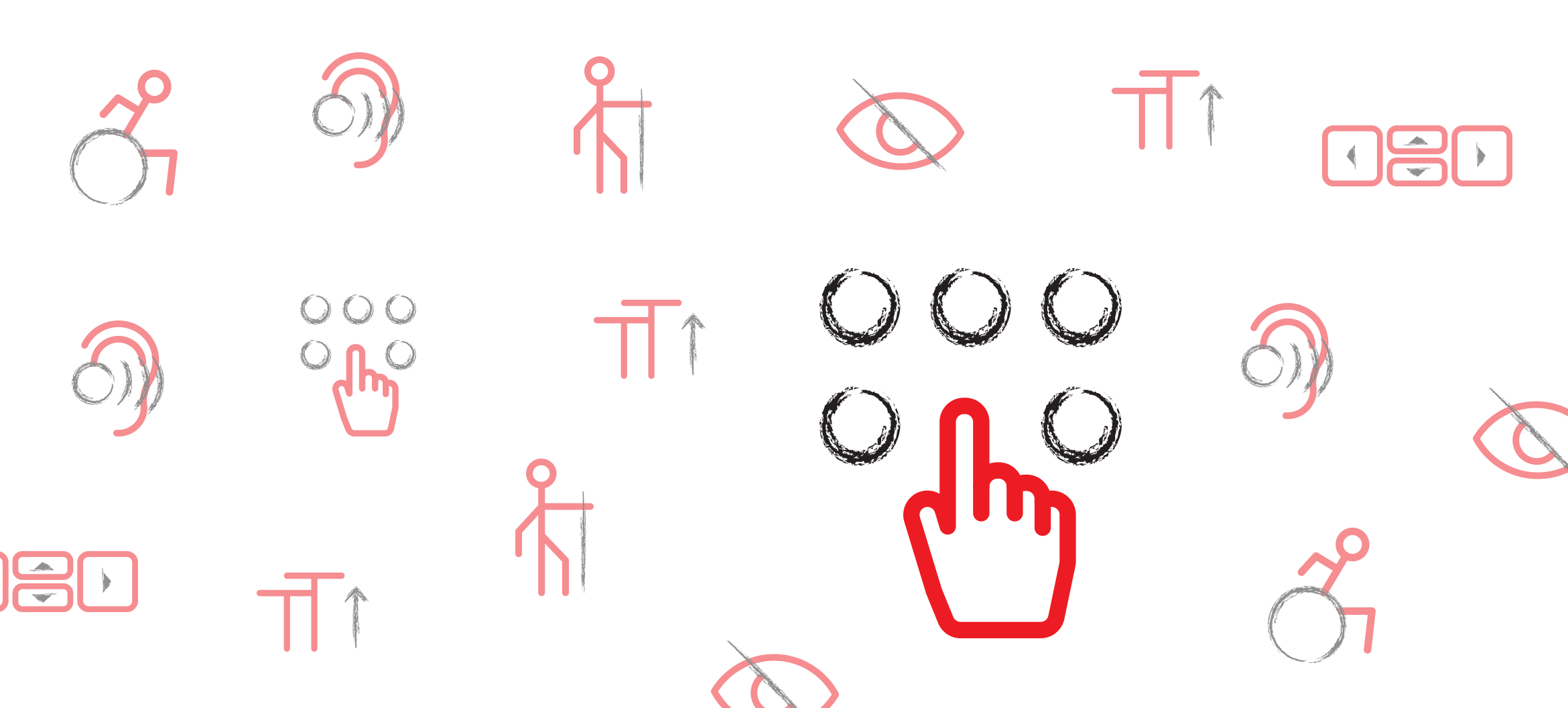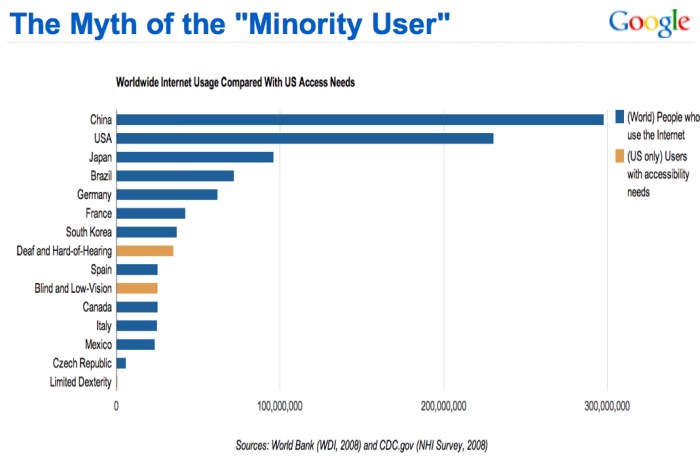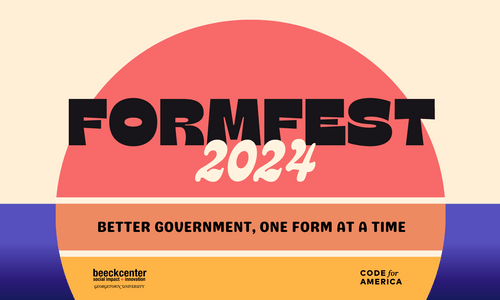
If you are trying to decide whether you need to make your website accessible to users with disabilities, you might wonder how much of the traffic on your website consists of people with disabilities. While this question is impossible to answer with certainty, one likely answer is this: If your site is difficult for this audience to access, they are probably not using it—they are going to a different site that is easier to use.
Websites typically have a purpose, which might be to raise funds for an organization, to increase public awareness about issues or events, to sell a product, or some combination of these. If you are limiting your audience, you are limiting the effectiveness of your website at achieving its intended purpose. Improving accessibility can help you to expand your audience, improve usability, improve your SEO, and in some cases, minimize your exposure to litigation.
How many people are you ignoring?
In the chart below, from research done by Naomi Black of Google in 2011, the blue bars represent the estimated size of the population of internet users in each country based on data from the World Bank as of 2008. The longest bar is for China, with approximately 300 million users. Then it shows the U.S.A with about 230 million, Japan with 90 million, followed by Brazil, Germany, France and South Korea.

The two yellow bars represent the population in the United States that have hearing impairments or vision impairments. The bar representing the number people in the United States who are deaf and hard-of-hearing is between the bars for all internet users in South Korea and Spain. Think about that - in 2008, the number people in the United States who are deaf and hard-of-hearing was greater than the entire population of internet users Spain. Between the blue bars for Spain and Canada is a yellow bar representing the blind and low-vision population in the United States. This indicates that the blind and low-vision population in the United States was greater than the entire population of internet users in Canada. While these specific statistics are 10 years old, the message of the chart has not changed with time - the population of internet users served by accessibility standards is not an insignificant minority.
United States Census statistics show that in 2012, 8.1 million people in the United States had impaired vision and 7.6 million had a hearing impairment. There are also other forms of disability that need to be considered when designing and building an accessible website. There were 19.9 million people in the U.S. who have difficulty lifting or grasping, which could affect their ability to use a mouse or keyboard, and 15.2 million with some form of cognitive, mental, or emotional impairment. Research commissioned by the Microsoft corporation indicates that the population with severe dexterity impairments comprises 7% of working age adults.
Future Needs for Accessible Websites
There are many reasons why the population that can benefit from accessibility features may increase in coming years. With advances in medical technology, more people are surviving injuries and living for many years with cognitive impairments or physical limitations. In addition, the U.S. population is ageing. Many of the people who were middle-aged as the web was exploding in popularity are now approaching or are in their senior years.
Census Bureau data shows that the U.S. population aged 65 and over increased from 12.4 percent to 15.2 percent of the overall population between 2000 and 2016. Typical effects of aging can include diminished hearing (needing captions or transcripts for video), more limitations on vision (requiring more contrast or larger text), reduced fine motor coordination (limiting the ability to use a mouse or touch screen effectively), and less focused concentration (preferring simple site structure and navigation). Many of the individuals in this population may not consider themselves to be disabled.
Accessibility and the Law
Even if you don’t want to expand your audience, improve the overall usability of your site, or boost your SEO, you might need an accessible website to comply with the law.
Section 508
If your organization receives Federal funding, your web site is subject to Section 508 of the Rehabilitation Act of 1973. Back in 1973, we didn’t have the internet that we know today, but in 1998 the Act was amended to require Federal agencies to make their electronic and information technology (EIT) accessible to people with disabilities. The Act covers contractors to Federal agencies in addition to organizations that receive funding from Federal agencies.
The requirements of Section 508 are legally enforceable. Any person with a disability may file an administrative complaint about a site deemed inaccessible, and may also be able to file a civil lawsuit. In order to enforce Section 508, the Federal government needed to identify what the term “accessible” means under the law. This was initially laid out by a set of requirements within Section 508, but not all of the requirements could not be measured or tested in an unambiguous way. The rules for determining whether a site is in compliance with Section 508 became more clear in 2017, when Section 508 was amended to incorporate by reference the accessibility standards outlined in Web Content Accessibility Guidelines version 2.0 (WCAG 2.0) produced by the World Wide Web Consortium (W3C).
The Americans with Disabilities Act
If you think you may be “off the hook” because your site is not Federally funded in any way, proceed with caution. A growing number of cases have indicated that judges are willing to interpret Title III of the Americans with Disabilities Act (ADA) more broadly, ruling that services available on commercial web sites should be available to all. One legal firm that specializes in ADA Title III litigation estimated that more than 800 federal lawsuits were filed over website accessibility in 2017.
The Department of Justice (DOJ), which is tasked with enforcing the ADA, has not yet issued a standard for website accessibility. The rule making process was initiated in July 2010, but was then placed on inactive status in December 2017 with no published guidance. This move by DOJ leaves the business community without a roadmap of steps to take for avoiding litigation. However, there is a growing body of case law that is referencing the WCAG 2.0 standards. It makes good business sense to heed the advice of a prominent disability rights attorney who urges companies to Spend Money on Web Access, Not Lawyers.
So, who needs an accessible website? You do, of course! If you want to learn more about WCAG 2.0, or how better accessibility also improves overall usability and SEO those topics will be covered soon. In the meantime, you can get in touch with any questions.




